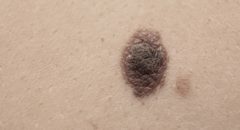 (BlackDoctor.org) — There is a myth that dark skin doesn’t burn, and therefore doesn’t need sunscreen. The reality is that all complexions can burn. Darker skin does provide some protection from the sun’s UV rays – it has more melanin for natural protection — but you can’t count on that alone. The extra melanin doesn’t guard against the UV damage that accelerates aging or causes cancer. The best thing for darker complexions to do is to begin each day by applying a sunscreen or moisturizer with an SPF of 15 to 30 — reapplying often while in direct sunlight.
(BlackDoctor.org) — There is a myth that dark skin doesn’t burn, and therefore doesn’t need sunscreen. The reality is that all complexions can burn. Darker skin does provide some protection from the sun’s UV rays – it has more melanin for natural protection — but you can’t count on that alone. The extra melanin doesn’t guard against the UV damage that accelerates aging or causes cancer. The best thing for darker complexions to do is to begin each day by applying a sunscreen or moisturizer with an SPF of 15 to 30 — reapplying often while in direct sunlight.
Following are common skin problems caused by sun exposure and tips on how to rescue your skin from the damage.
For Darkened Facial Skin
Changes in the skin’s pigmentation occur as we age and are very prominent in African American skin. Exposure to both ultraviolet A (UVA) and ultraviolet B (UVB) light stimulates the production of melanin which most likely accounts for darkening of the skin. There are 4 commonly occurring types of darkening.
• Localized areas on the face and neck
• More generalized areas on the face and neck
• Dark under eye circles
• Uneven skin tone
A way to treat the problem is to adopt the daily regimen of applying a SPF 15 or 30 sunscreen. For those who are experiencing pigmentary changes, a SPF 30 combined with a glycolic acid cream or lotion are recommended. Microdermabrasion and chemical peels are a great solution for African-Americans with this problem. It is recommended to undergo glycolic peels and, for sensitive skin, gentler salicylic peels.
For Hyperpigmentation
Hyperpigmentation — dark spots or splotches from UV-ray exposure — needs to be treated with a prescription for 4 percent hydroquinone, which is faster-acting and more effective than the over-the-counter variety. But make sure you don’t use a hydroquinone fader longer than six months, because a rare condition of permanently darkened skin tone could happen. If this occurs, take a break for a month or two and then resume treatment. The widely held idea among women of color that tanning will solve hyperpigmentation, by enabling the darker areas to blend in, is purely a myth.
For Dark Freckles
Another pigmentary problem caused by the sun is dermatosis papulosa nigra, or DPNs – a benign cutaneous condition common among blacks. It is usually characterized by small, brown or black bumps that are sometimes mistaken for moles. It is felt that a combination of heredity, aging and exposure to the sun are factors in the development of DPNs.
While not dangerous, they can easily be removed in a doctor’s office. Since there is no cream that has the ability to remove DPNs, treatment involves either excising (cutting) the lesions with as special surgical instrument, called a gradle scissor, or desiccating (burning) them with an electric needle. These procedures are well generally tolerated and healing generally occurs within one week. Side effects of removal may include light or dark skin discolorations which usually fade rapidly.
body { background: #FFF; }
body { background: #FFF; }
body { background: #FFF; }
body { background: #FFF; }
body { background: #FFF; }
body { background: #FFF; }








